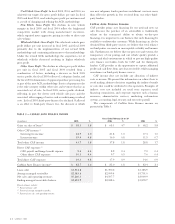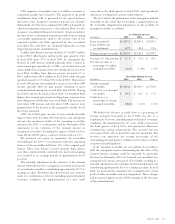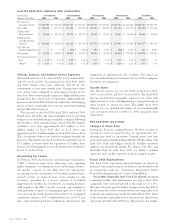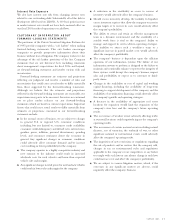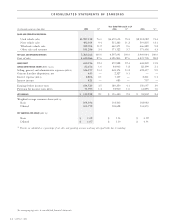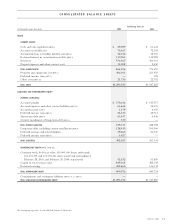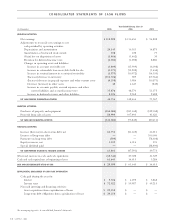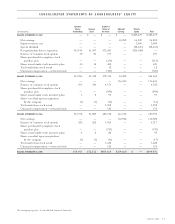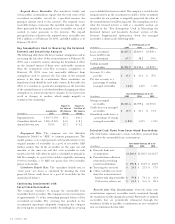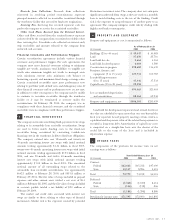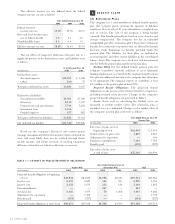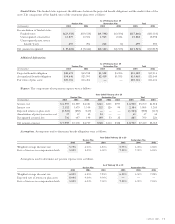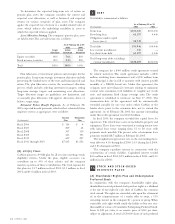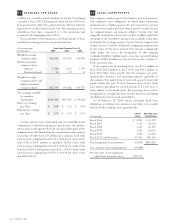CarMax 2005 Annual Report Download - page 34
Download and view the complete annual report
Please find page 34 of the 2005 CarMax annual report below. You can navigate through the pages in the report by either clicking on the pages listed below, or by using the keyword search tool below to find specific information within the annual report.
32
CARMAX 2005
BACKGROUND AND BASIS OF
PRESENTATION
CarMax, Inc. (“CarMax” and “the company”), including its
wholly owned subsidiaries, is the largest retailer of used cars and
light trucks in the United States. CarMax was the first used
vehicle retailer to offer a large selection of quality used vehicles
at low, “no-haggle” prices using a customer-friendly sales
process in an attractive, modern sales facility. CarMax also sells
new vehicles under various franchise agreements. CarMax
provides its customers with a full range of related services,
including the financing of vehicle purchases through its own
finance operation, CarMax Auto Finance (“CAF”), and third-
party lenders; the sale of extended service plans; and vehicle
repair service.
CarMax was formerly a subsidiary of Circuit City Stores, Inc.
(“Circuit City”). On October 1, 2002, the CarMax business was
separated from Circuit City through a tax-free transaction. As a
result of the separation, all of the businesses, assets, and liabilities
of the CarMax business are held in CarMax, Inc., an
independent, separately traded public company.
At the separation date, Circuit City and CarMax executed a
transition services agreement and a tax allocation agreement.
The transition services agreement specified initial service
periods ranging from 6 to 24 months, with varying renewal
options. The tax allocation agreement provided that the
preseparation taxes attributable to the business of each party
would be borne solely by that party.
SUMMARY OF SIGNIFICANT
ACCOUNTING POLICIES
(A) Principles of Consolidation
The consolidated financial statements include the accounts of
CarMax and its wholly owned subsidiaries. All significant
intercompany balances and transactions have been eliminated
in consolidation.
(B) Cash and Cash Equivalents
Cash equivalents of $18.0 million and $48.9 million at February 28,
2005, and February 29, 2004, respectively, consisted of highly
liquid debt securities with original maturities of three months or
less. Included in cash equivalents at February 28, 2005, and
February 29, 2004, were restricted cash deposits of $12.0 million
and $13.0 million, respectively, which were associated with
certain insurance deductibles. Additional restricted cash related
to auto loan receivables at February 29, 2004, was $6.4 million.
(C) Securitizations
The company uses a securitization program to fund substantially
all of the automobile loan receivables originated by CAF. The
company sells the automobile loan receivables to a wholly
owned, bankruptcy-remote, special purpose entity that transfers
an undivided interest in the receivables to a group of third-party
investors.This program is referred to as the warehouse facility.
The company periodically uses public securitizations to
refinance the receivables previously securitized through the
warehouse facility. In a public securitization, a pool of
automobile loan receivables is sold to a bankruptcy-remote,
special purpose entity that in turn transfers the receivables to a
special purpose securitization trust.
The transfers of receivables are accounted for as sales in
accordance with Statement of Financial Accounting Standards
(“SFAS”) No. 140, “Accounting for Transfers and Servicing of
Financial Assets and Extinguishments of Liabilities.” The
company retains an interest in the automobile loan receivables
that it securitizes. The retained interest presented on the
company’s consolidated balance sheets includes the present
value of the expected residual cash flows generated by the
securitized receivables, the restricted cash on deposit in various
reserve accounts, and an undivided ownership interest in the
receivables securitized through the warehouse facility and
certain public securitizations. The retained interest is carried at
fair value and changes in fair value are included in earnings. See
Notes 3 and 4 for additional discussion of securitizations.
(D) Fair Value of Financial Instruments
The carrying value of the company’s cash and cash equivalents,
receivables including automobile loan receivables, accounts
payable, short-term borrowings, and long-term debt
approximates fair value. The company’s retained interest in
securitized receivables and derivative financial instruments are
recorded on the consolidated balance sheets at fair value.
(E) Trade Accounts Receivable
Trade accounts receivable, net of an allowance for doubtful
accounts, include certain amounts due from finance companies
and customers, as well as from manufacturers for incentives and
warranty reimbursements, and for other miscellaneous
receivables. The estimate for doubtful accounts is based on
historical experience and trends.
(F) Inventory
Inventory is comprised primarily of vehicles held for sale or
undergoing reconditioning and is stated at the lower of cost or
market. Vehicle inventory cost is determined by specific
identification. Parts and labor used to recondition vehicles, as
well as transportation and other incremental expenses associated
with acquiring and reconditioning vehicles, are included in
inventory. Certain manufacturer incentives and rebates for new
car inventory, including holdbacks, are recognized as a
reduction to new car inventory when CarMax purchases the
vehicles. Volume-based incentives are recognized as a reduction
NOTES TO CONSOLIDATED FINANCIAL STATEMENTS
1
2


